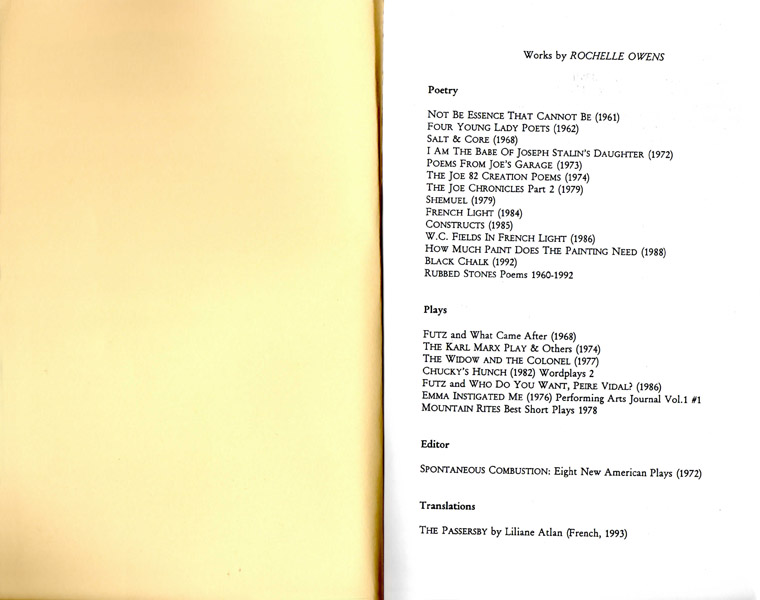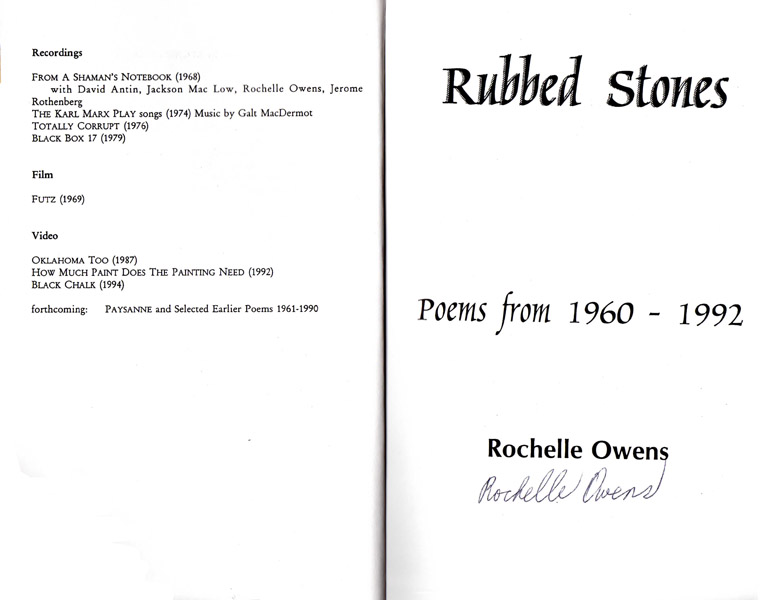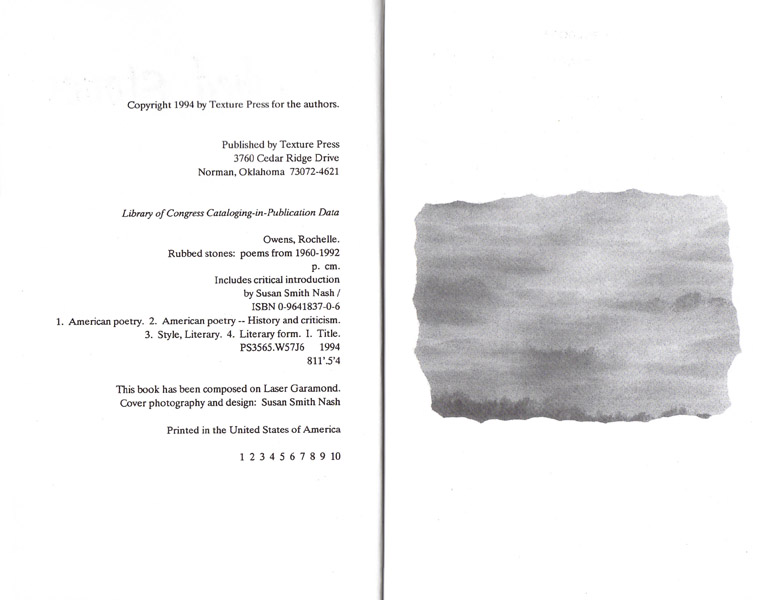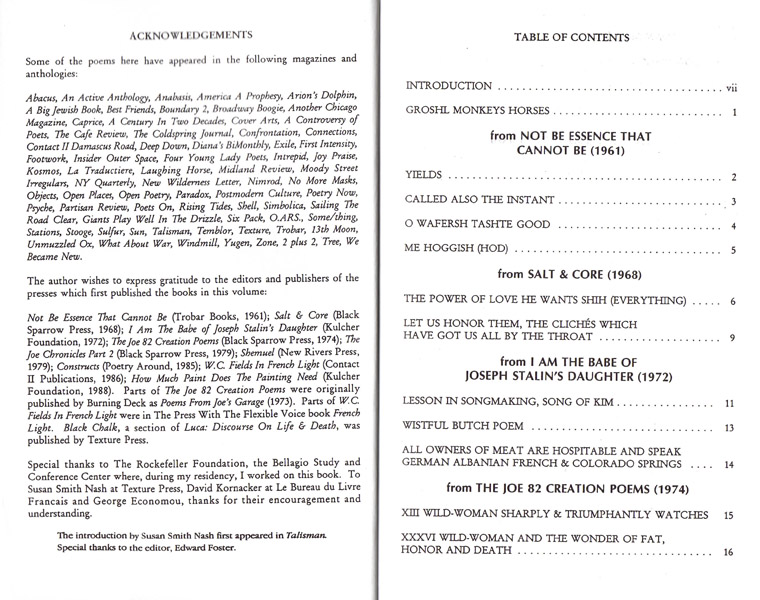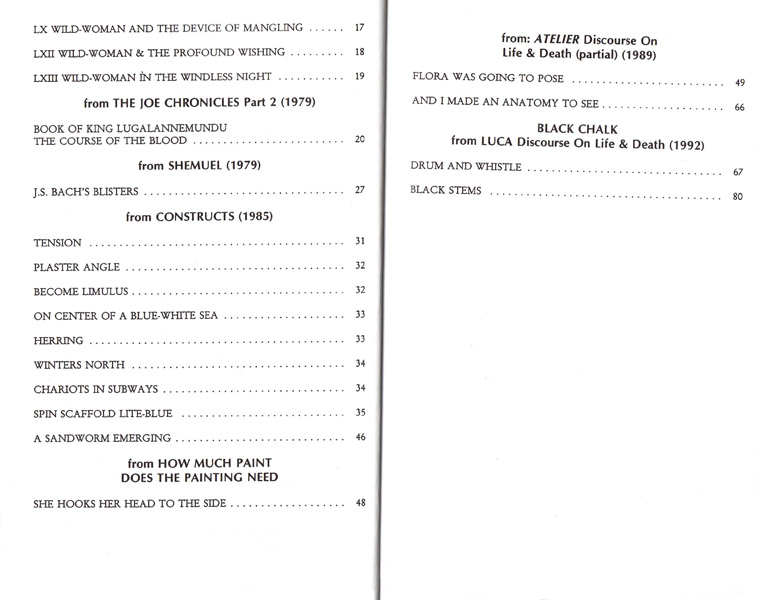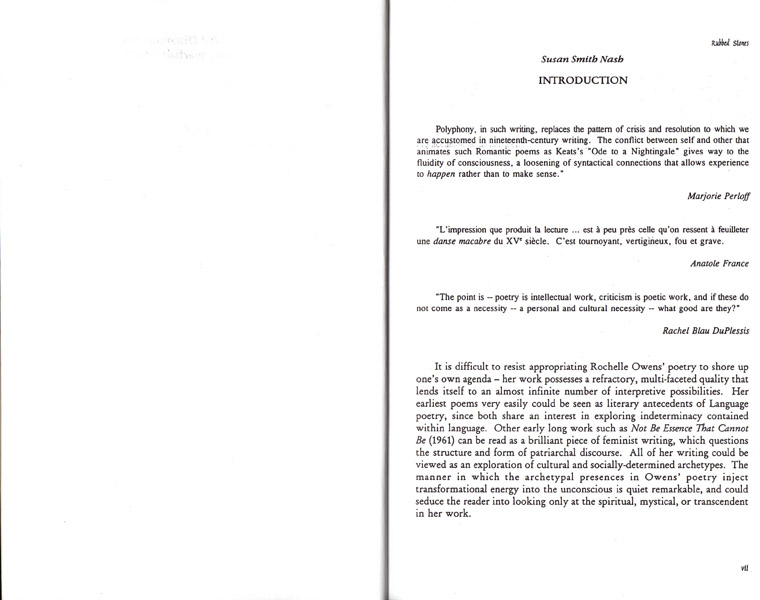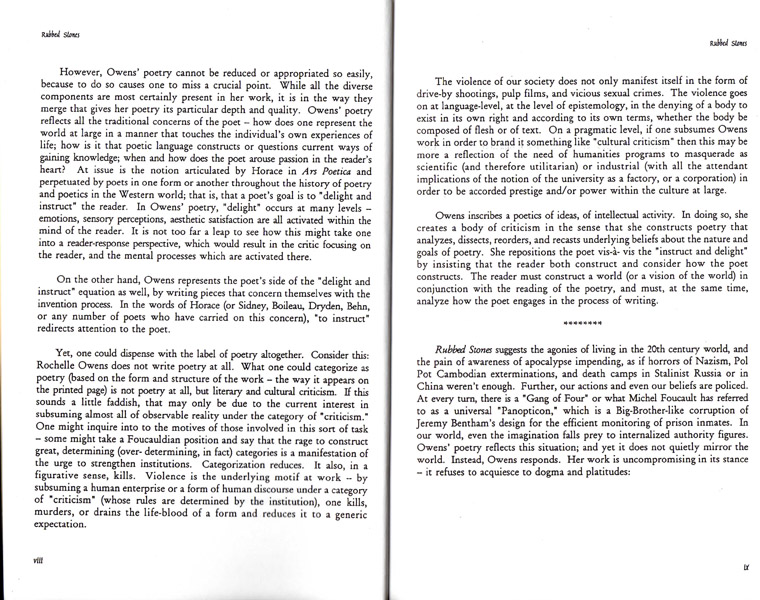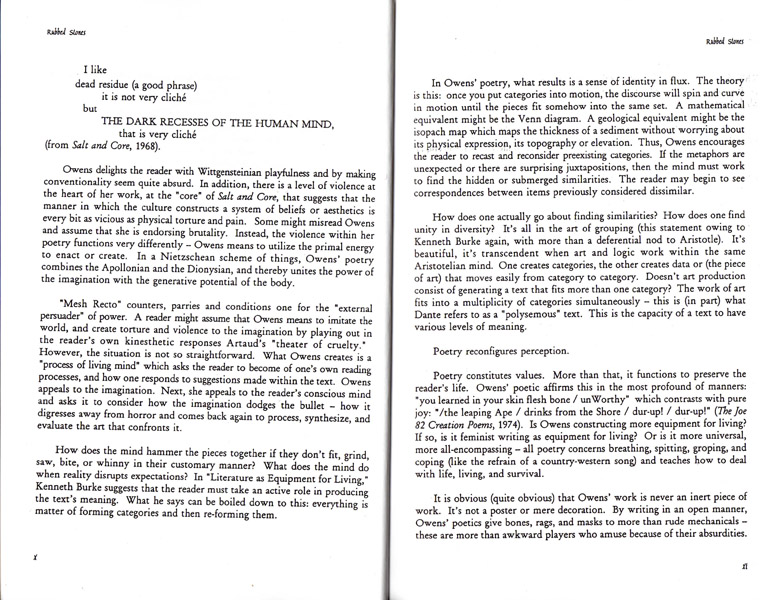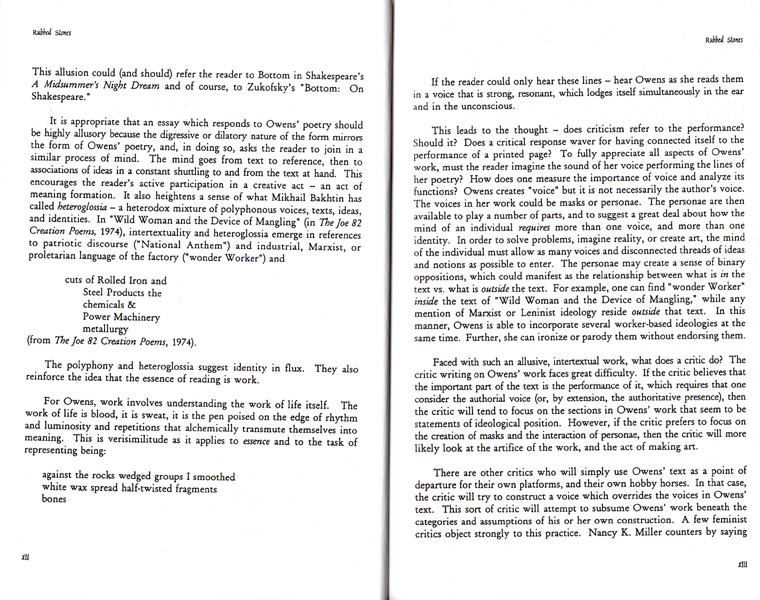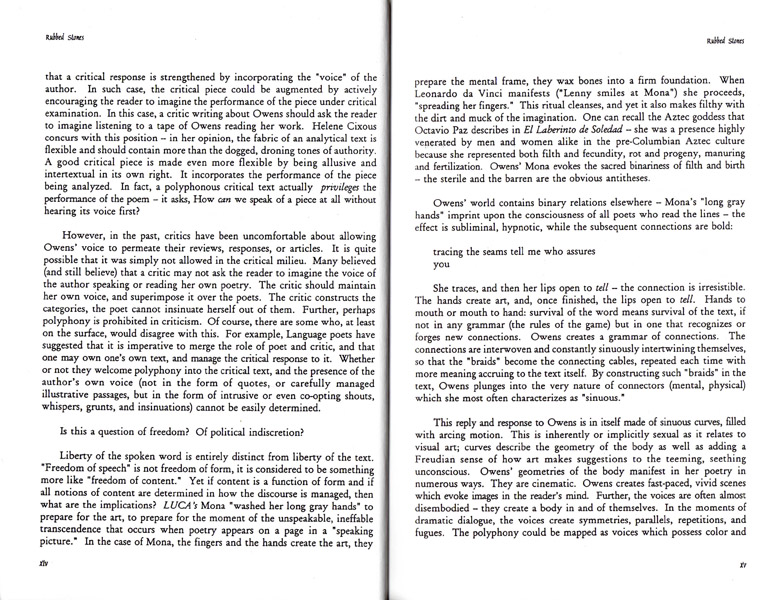Poetry Books
The Aardvark Venus: New & Selected Poems 1961-2020
Hermaphropoetics: Drifting Geometries
Out of Ur: New & Selected Poems 1961-2012
Solitary Workwoman
Luca: Discourse on Life and Death
New and Selected Poems 1961-1996
Rubbed Stones
Black Chalk
How Much Paint Does the Painting Need
W. C. Fields in French Light
Constructs
The Joe Chronicles Part 2
Shemuel
The Joe 82 Creation Poems
I Am the Babe of Joseph Stalin's Daughter
Salt and Core
Not Be Essence That Cannot Be
Rubbed Stones
1994, Texture Press
Polyphony, in such writing, replaces the pattern of crisis and resolution to which we are accustomed in nineteenth-century writing. The conflict between self and other that animates such Romantic poems as Keats's "Ode to a Nightingale" gives way to the fluidity of consciousness, a loosening of syntactical connections that allows experience to happen rather than to make sense."
Marjorie Perloff
"L'impression que produit la lecture ... est a peu pres celle qu'on ressent a feuilleter une danse macabre du XV siècle. C'est tournoyant, vertigineux, fou et grave.
Anatole France
"The point is poetry is intellectual work, criticism is poetic work, and if these do not come as a necessity—a personal and cultural necessity—what good are they?"
Rachel Blau DuPlessis
It is difficult to resist appropriating Rochelle Owens' poetry to shore up one's own agenda—her work possesses a refractory, multi-faceted quality that lends itself to an almost infinite number of interpretive possibilities. Her earliest poems very easily could be seen as literary antecedents of Language poetry, since both share an interest in exploring indeterminacy contained within language. Other early long work such as Not Be Essence That Cannot Be (1961) can be read as a brilliant piece of feminist writing, which questions the structure and form of patriarchal discourse. All of her writing could be viewed as an exploration of cultural and socially-determined archetypes. The manner in which the archetypal presences in Owens' poetry inject transformational energy into the unconscious is quiet remarkable, and could seduce the reader into looking only at the spiritual, mystical, or transcendent in her work.
However, Owens' poetry cannot be reduced or appropriated so easily, because to do so causes one to miss a crucial point. While all the diverse components are most certainly present in her work, it is in the way they merge that gives her poetry its particular depth and quality. Owens' poetry reflects all the traditional concerns of the poet—how does one represent the world at large in a manner that touches the individual's own experiences of life; how is it that poetic language constructs or questions current ways of gaining knowledge; when and how does the poet arouse passion in the reader's heart? At issue is the notion articulated by Horace in Ars Poezica and perpetuated by poets in one form or another throughout the history of poetry and poetics in the Western world; that is, that a poet's goal is to "delight and instruct" the reader. In Owens' poetry, "delight" occurs at many levels—emotions, sensory perceptions, aesthetic satisfaction are all activated within the mind of the reader. It is not too far a leap to see how this might take one into a reader-response perspective, which would result in the critic focusing on the reader, and the mental processes which are activated there.
On the other hand, Owens represents the poet's side of the "delight and instruct" equation as well, by writing pieces that concern themselves with the invention process. In the words of Horace (or Sidney, Boileau, Dryden, Behn, or any number of poets who have carried on this concern), "to instruct" redirects attention to the poet.
Yet, one could dispense with the label of poetry altogether. Consider this: Rochelle Owens does not write poetry at all. What one could categorize as poetry (based on the form and structure of the work—the way it appears on the printed page) is not poetry at all, but literary and cultural criticism. If this sounds a little faddish, that may only be due to the current interest in subsuming almost all of observable reality under the category of "criticism." One might inquire into to the motives of those involved in this sort of task—some might take a Foucauldian position and say that the rage to construct great, determining (over-determining, in fact) categories is a manifestation of the urge to strengthen institutions. Categorization reduces. It also, in a figurative sense, kills. Violence is the underlying motif at work—by subsuming a human enterprise or a form of human discourse under a category of "criticism" (whose rules are determined by the institution), one kills, murders, or drains the life-blood of a form and reduces it to a generic expectation.
The violence of our society does not only manifest itself in the form of drive-by shootings, pulp films, and vicious sexual crimes. The violence goes on at language-level, at the level of epistemology, in the denying of a body to exist in its own right and according to its own terms, whether the body be composed of flesh or of text. On a pragmatic level, if one subsumes Owens work in order to brand it something like "cultural criticism" then this may be more a reflection of the need of humanities programs to masquerade as scientific (and therefore utilitarian) or industrial (with all the attendant implications of the notion of the university as a factory, or a corporation) in order to be accorded prestige and/or power within the culture at large.
Owens inscribes a poetics of ideas, of intellectual activity. In doing so, she creates a body of criticism in the sense that she constructs poetry that analyzes, dissects, reorders, and recasts underlying beliefs about the nature and goals of poetry. She repositions the poet vis-a-vis the "instruct and delight" by insisting that the reader both construct and consider how the poet constructs. The reader must construct a world (or a vision of the world) in conjunction with the reading of the poetry, and must, at the same time, analyze how the poet engages in the process of writing.
**********
Rubbed Stones suggests the agonies of living in the 20th century world, and the pain of awareness of apocalypse impending, as if horrors of Nazism, Pol Pot Cambodian exterminations, and death camps in Stalinist Russia or in China weren't enough. Further, our actions and even our beliefs are policed. At every turn, there is a "Gang of Four" or what Michel Foucault has referred to as a universal "Panopticon," which is a Big-Brother-like corruption of Jeremy Bentham's design for the efficient monitoring of prison inmates. In our world, even the imagination falls prey to internalized authority figures. Owens' poetry reflects this situation; and yet it does not quietly mirror the world. Instead, Owens responds. Her work is uncompromising in its stance—it refuses to acquiesce to dogma and platitudes:
I like
dead residue (a good phrase)
it is not very eliché
but
THE DARK RECESSES OF THE HUMAN MIND,
that is very cliché
(from Salt and Core, 1968).
Owens delights the reader with Wittgensteinian playfulness and by making conventionality seem quite absurd. In addition, there is a level of violence at the heart of her work, at the "core" of Salt and Core, that suggests that the manner in which the culture constructs a system of beliefs or aesthetics is every bit as vicious as physical torture and pain. Some might misread Owens and assume that she is endorsing brutality. Instead, the violence within her poetry functions very differently—Owens means to utilize the primal energy to enact or create. In a Nietzschean scheme of things, Owens' poetry combines the Apollonian and the Dionysian, and thereby unites the power of the imagination with the generative potential of the body.
"Mesh Recto" counters, parties and conditions one for the "external persuader" of power. A reader might assume that Owens means to imitate the world, and create torture and violence to the imagination by playing out in the reader's own kinesthetic responses Artaud's "theater of cruelty." However, the situation is not so straightforward. What Owens creates is a "process of living mind" which asks the reader to become of one's own reading processes, and how one responds to suggestions made within the text. Owens appeals to the imagination. Next, she appeals to the reader's conscious mind and asks it to consider how the imagination dodges the bullet—how it digresses away from horror and comes back again to process, synthesize, and evaluate the an that confronts it.
How does the mind hammer the pieces together if they don't fit, grind, saw, bite, or whinny in their customary manner? What does the mind do when reality disrupts expectations? In "Literature as Equipment for Living," Kenneth Burke suggests that the reader must take an active role in producing the text's meaning. What he says can be boiled down to this: everything is matter of forming categories and then re-forming them.
In Owens' poetry, what results is a sense of identity in flux. The theory is this: once you put categories into motion, the discourse will spin and curve in motion until the pieces fit somehow into the same set. A mathematical equivalent might be the Venn diagram. A geological equivalent might be the isopach map which maps the thickness of a sediment without worrying about its physical expression, its topography or elevation. Thus, Owens encourages the reader to recast and reconsider preexisting categories. If the metaphors are unexpected or there are surprising juxtapositions, then the mind must work to find the hidden or submerged similarities. The reader may begin to see correspondences between items previously considered dissimilar.
How does one actually go about finding similarities? How does one find unity in diversity? It's all in the art of grouping (this statement owing to Kenneth Burke again, with more than a deferential nod to Aristotle). It's beautiful, it's transcendent when art and logic work within the same Aristotelian mind. One creates categories, the other creates data or (the piece of art) that moves easily from category to category. Doesn't art production consist of generating a text that fits more than one category? The work of art fits into a multiplicity of categories simultaneously—this is (in part) what Dante refers to as a "polysemous" text. This is the capacity of a text to have various levels of meaning.
Poetry reconfigures perception.
Poetry constitutes values. More than that, it functions to preserve the reader's life. Owens' poetic affirms this in the most profound of manners: "you learned in your skin flesh bone / unWorthy" which contrasts with pure joy: "/the leaping Ape / drinks from the Shore / dur-up! / dur-up!" (The Joe 82 Creation Poems, 1974). Is Owens constructing more equipment for living? If so, is it feminist writing as equipment for living? Or is it more universal, more all-encompassing—all poetry concerns breathing, spitting, groping, and coping (like the refrain of a country-western song) and teaches how to deal with life, living, and survival.
It is obvious (quite obvious) that Owens' work is never an inert piece of work. It's not a poster or mere decoration. By writing in an open manner, Owens' poetics give bones, rags, and masks to more than rude mechanicals—these are more than awkward players who amuse because of their absurdities. This allusion could (and should) refer the reader to Bottom in Shakespeare's A Midsummer's Night Dream and of course, to Zukofsky's "Bottom: On Shakespeare."
It is appropriate that an essay which responds to Owens' poetry should be highly allusory because the digressive or dilatory nature of the form mirrors the form of Owens' poetry, and, in doing so, asks the reader to join in a similar process of mind. The mind goes from text to reference, then to associations of ideas in a constant shuttling to and from the text at hand. This encourages the reader's active participation in a creative act—an act of meaning formation. It also heightens a sense of what Mikhail Bakhtin has called heteroglossia—a heterodox mixture of polyphonous voices, texts, ideas, and identities. In "Wild Woman and the Device of Mangling" (in The Joe 82 Creation Poems, 1974), intertextuality and heteroglossia emerge in references to patriotic discourse ("National Anthem") and industrial, Marxist, or proletarian language of the factory ("wonder Worker") and
cuts of Rolled Iron and
Steel Products the
chemicals 8:
Power Machinery
metallurgy
(from The Joe 82 Creation Poems, 1974).
The polyphony and heteroglossia suggest identity in flux. They also reinforce the idea that the essence of reading is work.
For Owens, work involves understanding the work of life itself. The work of life is blood, it is sweat, it is the pen poised on the edge of rhythm and luminosity and repetitions that alchemically transmute themselves into meaning. This is verisimilitude as it applies to essence and to the task of representing being:
against the rocks wedged groups I smoothed
white wax spread half-twisted fragments
bones
If the reader could only hear these lines—hear Owens as she reads them in a voice that is strong, resonant, which lodges itself simultaneously in the ear and in the unconscious.
This leads to the thought—does criticism refer to the performance? Should it? Does a critical response waver for having connected itself to the performance of a printed page? To fully appreciate all aspects of Owens' work, must the reader imagine the sound of her voice performing the lines of her poetry? How does one measure the importance of voice and analyze its functions? Owens creates "voice" but it is not necessarily the author's voice. The voices in her work could be masks or personae. The personae are then available to play a number of parts, and to suggest a great deal about how the mind of an individual requires more than one voice, and more than one identity. In order to solve problems, imagine reality, or create art, the mind of the individual must allow as many voices and disconnected threads of ideas and notions as possible to enter. The personae may create a sense of binary oppositions, which could manifest as the relationship between what is in the text vs. what is outside the text. For example, one can find "Wonder Worker" inside the text of "Wild Woman and the Device of Mangling," while any mention of Marxist or Leninist ideology reside outside that text. In this manner, Owens is able to incorporate several worker-based ideologies at the same time. Further, she can ironize or parody them without endorsing them.
Faced with such an allusive, intertextual work, what does a critic do? The critic writing on Owens' work faces great difficulty. If the critic believes that the important part of the text is the performance of it, which requires that one consider the authorial voice (or, by extension, the authoritative presence), then the critic will tend to focus on the sections in Owens' work that seem to be statements of ideological position. However, if the critic prefers to focus on the creation of masks and the interaction of personae, then the critic will more likely look at the artifice of the work, and the act of making art.
There are other critics who will simply use Owens' text as a point of departure for their own platforms, and their own hobby horses. In that case, the critic will try to construct a voice which overrides the voices in Owens' text. This sort of critic will attempt to subsume Owens' work beneath the categories and assumptions of his or her own construction. A few feminist critics object strongly to this practice. Nancy K. Miller counters by saying that a critical response is strengthened by incorporating the "voice" of the author. In such case, the critical piece could be augmented by actively encouraging the reader to imagine the performance of the piece under critical examination. In this case, a critic writing about Owens should ask the reader to imagine listening to a tape of Owens reading her work. Helene Cixous concurs with this position—in her opinion, the fabric of an analytical text is flexible and should contain more than the dogged, droning tones of authority. A good critical piece is made even more flexible by being allusive and intertextual in its own right. It incorporates the performance of the piece being analyzed. In fact, a polyphonous critical text actually privileges the performance of the poem—it asks, How can we speak of a piece at all without hearing its voice first?
However, in the past, critics have been uncomfortable about allowing Owens' voice to permeate their reviews, responses, or articles. It is quite possible that it was simply not allowed in the critical milieu. Many believed (and still believe) that a critic may not ask the reader to imagine the voice of the author speaking or reading her own poetry. The critic should maintain her own voice, and superimpose it over the poes. The critic constructs the categories, the poet cannot insinuate herself out of them. Further, perhaps polyphony is prohibited in criticism. Of course, there are some who, at least on the surface, would disagree with this. For example, Language poets have suggested that it is imperative to merge the role of poet and critic, and that one may own one's own text, and manage the critical response to it. Whether or not they welcome polyphony into the critical text, and the presence of the author's own voice (not in the form of quotes, or carefully managed illustrative passages, but in the form of intrusive or even co-opting shouts, whispers, grunts, and insinuations) cannot be easily determined.
Is this a question of freedom? Of political indiscretion?
Liberty of the spoken word is entirely distinct from liberty of the text. "Freedom of speech" is not freedom of form, it is considered to be something more like "freedom of content." Yet if content is a function of form and if all notions of content are determined in how the discourse is managed, then what are the implications? LUCA's Mona "washed her long gray hands" to prepare for the art, to prepare for the moment of the unspeakable, ineffable transcendence that occurs when poetry appears on a page in a 'speaking picture.' In the case of Mona, the fingers and the hands create the art, they prepare the mental frame, they wax bones into a firm foundation. When Leonardo da Vinci manifests ("Lenny smiles at Mona") she proceeds, "spreading her fingers." This ritual cleanses, and yet it also makes filthy with the dirt and muck of the imagination. One can recall the Aztec goddess that Octavio Paz describes in El Laberinto de Soledad—she was a presence highly venerated by men and women alike in the pre-Columbian Aztec culture because she represented both filth and fecundity, rot and progeny, manuring and fertilization. Owens' Mona evokes the sacred binariness of filth and birth—the sterile and the barren are the obvious antitheses.
Owens' world contains binary relations elsewhere—Mona's "long gray hands" imprint upon the consciousness of all poets who read the lines—the effect is subliminal, hypnotic, while the subsequent connections are bold:
tracing the seams tell me who assures
you
She traces, and then her lips open to tell—the connection is irresistible. The hands create art, and, once finished, the lips open to tell. Hands to mouth or mouth to hand: survival of the word means survival of the text, if not in any grammar (the rules of the game) but in one that recognizes or forges new connections. Owens creates a grammar of connections. The connections are interwoven and constantly sinuously intertwining themselves, so that the "braids" become the connecting cables, repeated each time with more meaning accruing to the text itself. By constructing such "braids" in the text, Owens plunges into the very nature of connectors (mental, physical) which she most often characterizes as "sinuous."
This reply and response to Owens is in itself made of sinuous curves, filled with arcing motion. This is inherently or implicitly sexual as it relates to visual art; curves describe the geometry of the body as well as adding a Freudian sense of how art makes suggestions to the teeming, seething unconscious. Owens' geometries of the body manifest in her poetry in numerous ways. They are cinematic. Owens creates fast-paced, vivid scenes which evoke images in the reader's mind. Further, the voices are often almost disembodied—they create a body in and of themselves. In the moments of dramatic dialogue, the voices create symmetries, parallels, repetitions, and fugues. The polyphony could be mapped as voices which possess color and geometry as well as sound, an interplay of scenes that could be from Fantasia or Friz Lang's Metropolis. Parts of the body dominate the frames—long gray hands, fingers, dead muscle, thin long hair. The proportions of the bodies are manipulated, so that the hands or the hair may overshadow the trunk.
Owens constructs a poetic apparatus to reconfigure the body. At times, the apparatus appears as dissection—in LUCA, the anatomical experiments of Leonardo da Vinci Figure prominently:
you do not blame my choice he traced
skin seeing his breast silvered her
sketches drawing obscene caricatures
The sketches and 'obscene caricatures" connect body and artistry—as da Vinci dissects a cadaver to understand what is beneath the skin, he also opens up a new way to see the body. Owens' poetry functions as da Vinci's knife—it opens the body for the reader to see it in an entirely new light. Further, Owens' strokes are precise,fine, and deliberate, which suggests to the reader that slicing the musculature of language and perception requires deftness and strength.
Perhaps a connection between dissection and Cubism is unavoidable, especially if one considers that Cubist art is a manifestation of the 20th-century impulse to look at the device laid bare, to gaze upon the mechanical underneath that drives the machine, the factory, the society, the individual. In "Groshl Monkeys Horses" (1961), Owens' cut, dissected language suggests even more than the appearance of Cubist art. One can see the essence or the ontology of the relationship between language and how one reads a poem. However, Owens does not rest with the dissection motif—her geometries of the body are highly mathematical. In Constructs (1985), her language is precise and technical:
Z minus the straight-edge level diagonal
curve cutting fill all nail holes.
The mathematical relationships in this poem suggest how it is possible to create patterns in language that describe the intricate interactions between body, language, and systems of knowledge.
In a 1969 essay, 'The Birth of Cubism' Peter Berger suggested that Cubist art refers to the diagram—it diagrams one version of the interplay of reality and art, the interplay of the person and the thing. Owens' poetry is not Cubist in the same manner as William Carlos Williams who applied Cubist notions to language in order to develop a highly visual, minimalist poem. Instead, Owens extends the principles of cubism in order to create diagrams of urge and generative force. In this case, the diagram is the determining motif. The diagram may represent the underlying structure of one entity, or it may model the relationship of the structures of two or more disparate entities. In either case, what is implied here is that art no longer attempts the Renaissance ideal of replicating perspective in one certain, verisimilitudinous manner. Thus, Owens constructs diagrams of urge. She represents the perspective of desire, and of life-generating energy.
All art replicates perspective. However, perspective is not always foregrounded, or given preferential importance. By extension, all poetry replicates perspective—that is, the orientation of objects, things, feelings, or abstractions. Owens both questions and employs the diagram as a method of conveying the essence of urge and the artistic process. For example, in How Much Paint Does the Painting Need? Owens concerns herself with perspective production, here in the persona of Vincent Van Gogh:
And I gave my brief turbulent mad genius legend
or tragic life idealization my colorful palette
megalithic anxiety I PAINT I PAINT
In doing so, she redraws the Romantic perspective, where the artist's idea of self is projected into the landscape or the subject of the painting, so that the work of art is expected to function as an expression of the self (in particular, the self of the artist). In contrast, Owens' emphasis on the way anatomy is sketched, drawn, caricatured, or molded in Mona's "long gray hands" suggests that art or poetry can function as a diagram of structure and a map of relationships. Language is the medium that forges ties in the diagram or map. Language does more than describe the world, it creates relationships, and arranges knowledge.
Art production (plastic arts and poetics) creates diagrams or blueprints of an epistemology. In Rubbed Stones as in the large lifework, LUCA: Discourses on Life and Death, the recurring presence of braids—the sinuous ropes—invites the reader to construct an allegory of connection. On another level (an analogical one), the ropes connect the reader to abstract thought, and they suggest that we are able to look at ropes (and all repetitions) as a way to come to knowledge of our own salvation' ln French Light (1984), Owens describes the process in physical terms:
Fission breaking
the principle of
combinations.
elements dangerous,
mental crucibles
Striking fire
Pearls in my glowing hands
The ropes, or the "fission breaking the principle of combinations" may "rescue" the reader (Linda Reinfeld uses this term advisedly in her book on Language poetry, Language Poetry: Writing as Rescue, to denote the manner in which language can help one escape a Nietzschean "prisonhouse of language") from a tight, airless world of rules and language and give her or him structural components upon which to build a world.
If Owens' sinuous braids, or ropes do not precisely "rescue" they at least are available for the reader to grip, manipulate, and twist into connections. We, as readers, lash ourselves together. We lash ourselves to the deck of a ship during a nightmarish storm in the same manner that we lash ourselves to God. As a reader, it is almost impossible to believe, even if rather narcissistically, that Owens' world, with its violence, flesh and throbbing bloody flux of life is not a generative one. It seems to contain God, with no claims made at all to the gender or behavior of God, merely that there is a source of all life and a point of all creation. At any rate, we braid ourselves into this world, and we braid our breath with God's breath:
Then she manipulated analyzed tightening
the whitish fibers
**********
If Owens' work is a "blood biography" of sorts, it is a "dramatic blood/combining the letters" (French Light, 1984). Owens calls into question traditional ideas of history. In doing so, she asks how it is that chronologies, casualties, and contingencies interconnect in a narrative that we label a history? The personae in Rubbed Stones and LUCA arefigures from history. They also represent articulations of what history-writers have considered important (that is, how are these persons considered to have shaped subsequent events?). An event is considered important if it is generally believed that it causedothers to happen, and yet, the dangers of this type of logic insinuate themselves into the very fabric of what we'd like to call truth, reality, or an ethical absolute. For years, historians wrote that Columbus' arrival in the Americas influenced others to make the voyage. His action was considered a precipitating event. But, who decides how Columbus influenced subsequent generations? How are those decisions made?
In the Joe Chronicles Part 2(1979), Owens redefines T. S. Eliot's "we live in an old chaos of the sun" by deliberately shaping chaos in and out of the "formlessness of form." She investigates the urges that lie behind the need to order events into such a narrative: "holy monotonous history reshaped because I desire" (Joe Chronicles Part 2 1979). This differs from Charles Olson's poetic constructions of history in Maximus Poems in many ways. First, Owens utilizes a series of masks and personae, so that the author's voice and identity are effaced. In this way, Owens' narrative merges with the trader's own vocabulary, leading to a deep internalization of the structure itself. Further, Owens' work differs from Olson's historical long poem in its tone. She ironizes, parodies, and satirizes the epic form, particularly self-aggrandizing heroic epics. In this sense, The Joe Chronicles Part 2 flow more from a Rabelaisian tradition of absurdist bildungsroman or kunstleroman. The adventures of the child of King Lugalannemundu resemble those of Gargantua, who can be viewed alternately as an innocent naif or an amazingly prescient observer who has the genius of seeing custorus and language honestly, stripped of their conventions. Some recent Language poets have attempted similar work, but their rehistoricizations achieve only a "formlessness of form" and not the wild, parodic energy of Owens' Rabelaisian apocalyptic epics.
Leonardo, Mona, Sigmund populate the pages of LUCA. Owens employs them to construct a particular anti-narrative. Anti-narrative as used here denotes a writing that does not buy into the "chain of events" notion of history, but, significantly, neither does the anti-narrative endorse deconstruction or new historicism. In fact, Owens counters Michel Foucault's early notions that history chroniclers merely map the surges and retreats of ideology. Owens counters the more dogmatic of the hegemony brokers a new Language of history—this language does not assume hierarchical positions and it is not constructed to replicate or expose power relations. What this language does is make fluid the boundaries of history and thus its margins of influence. If Sigmund Freud and Leonardo da Vinci influence us, it is because they lodge their language in our consciousness. In LUCA, they recur at unexpected times in seemingly absurd contexts (as absurd as in life. that is to say, not in the context of a neatly organized chronology).
Lenny and Sigmund are icons that reflect ourselves as we perceive ourselves. The shift in their appearance reflects our own shifting, chemically bubbling, metamorphosing minds. First Lenny then Siggy then Siggy then Lenny—Mona (Mona Lisa) conveniently manifests as pure icon in the world. She is first a painting (therefore a creation) and second the inspiring force that became the subject of art production. If Mona is the subject of a painting, she is also the object of the painter's gaze. In the act of painting, she becomes the identity of an era (Blake wrote that only by studying particulars can one derive an idea of the universal—Mona Lisa the particular that allows one to understand the essence of the times). If this is so, what does this say about the context—the era—if the Renaissance can be understood as an age that privileged individual achievement, the time when the individual was believed to be an unbounded, unboundable, neo-platonic, master and manipulator of the Great Chain of Being (a la Lovejoy's analysis).
Mona is master and manipulator of the Great Chain of Being.
Mona Lisa is this powerful, and she is more. Her identity is not confined to Jungian 'the feminine' aspects of the feminine as 'anima" and principles of the feminine. Mona Lisa becomes consciousness itself. and her presence in Owens' work concern themselves with how words and text enter the mind as language or parole and how they transmute knowledge into a visual correlative.
This may or may not be what we call the imagination, or what the rationalists described as a faculty of the mind analogous to a machine where stored sensory impression are mechanically processed with current ones. Joseph Addison wrote that the imagination creates an image of a thing while one is reading, and how the mind compares what appears with what is expected. If the two differ, there is the backbone of "wit." Thus, "wit" is essentially a mental (cognitive) process. When a writer disrupts generic expectations, she or he sets the stage for "wit." The same process could be applied to irony, parody, the fantastic, and even the grotesque.
In LUCA, one cannot avoid Mona Lisa's allegorical function as the spirit of invention. Mona Lisa also possesses a metonymic function when she stands for the whole of Renaissance Italy's outpouring of art, literature, science, architecture, and intellectual history. As such, she also stands for the efflorescence of art and science, especially of an art that celebrates the potential of the individual. Mona Lisa may also function to represent the process of assigning value, and the decision-making process. Art that the culture says belongs in museums (the Louvre) reflects the capacity of the entire world to venerate one cultural thread (Western civilization) even if it is an alien, seemingly irrelevant culture which has been imposed due to colonialism or economic opportunism.
Rubbed Stones is a lucky break for those who haven't been able to put together a complete set of Rochelle Owens' books for their own library. This collection highlights works from ten previous books.
Writing this review was on my mind when I walked down and into the office of one of my co-workers. I'd been studying Rochelle Owens' poems and thinking about them like mad. I had the advantage of hearing her read on several occasions and having been fascinated for years by the primordial energy and underlying apocalyptic motif in her voice, I was hearing her live even as I popped into my friend's office. There on the wall behind his desk was a xerox of a collage that said "DESTROY THAT WHICH BORES YOU!" in twenty-four point Futura Bold Condensed. The rest of the text, with lines like "...alienated voids who hang their brainwashed heads out to dry on every occasion only to find them burned out by the routines they insist are practical and responsible ..." and the collage of tangled images, from the well-known hands advertising Palmolive diswhashing liquid to a morass of video plugs and wires, was an immediate cut into the poems ricocheting off the sides of my mind. The collage was from an AK Press book, Ecstatic Incisions: The Collages of Freddie Baer (the text for this one by Jim Gilman). I thought this is so much what Rochelle Owens is about. Certainly no one could ever accuse her work of being boring. In fact, a central theme of Ownes' work could be identified as that courageous "Jeanne d'Arc gallop" into and against the barricades of boredom.
One can almost see her armor glinting in the sun and feel the pounding of the hooves in each poem, with Owens charging out anew across the rugged turf of that field. One feels an almost mystical violence in her approach to claiming a rescued hill or to charging and/or changing what Susan Smith Nash calls in her definitive introduction, "the structure and form of patriarchal discourse." This discourse is really a cultural criticism, an uprising against a staid and conservative definition of what one should be and how one should feel about things; against that pragmatic violence that exists couched in language. Owens' refusal to compromise or acquiesce to the political grammar of the status quo is a testimony to her commitment to challenging the platitudinous definition of an individual's own experience of life (or of the world at large) that the Powers That Be have laid out for us all. She is constantly questioning how poetic language configures in that quest of gaining knowledge, and any apparent confusion she raises in the reader is actually a creative matrix. She casts aside the dogma and commercialized Hallmark Card aphorisms and goes cold turkey on the agony and delight of living in this century, complete with the pain of awareness, the violence of critical change and the unabashed passion of being. Susan Smith Nash reminds us of how even the imagination can fall prey to internalized authority figures; and hand-in-hand with that, how tragically simple it can be for us to slip into deadening conventionality. But Owens refuses to let us go. She is not the silent mirror on the night stand, more the Shaman-genius exploring deeper realities in the psychic realm. She reaches down into the living, breathing mythical core and pulls up the forces of chaos, spitting and kicking; she gives us back the hungry power of our own imaginations.
This is a book of poems to burn a hole in your pocket, to wake you in the dead of night like a scream, to make what you thought yesterday seem absurd, to snatch you up playfully and inspire an assailant on those battlements on the other side of that messy turf. From "A Sandworm Emerging': "I remember the woman/ in mutton-sleeves who/ breathed scalding steam/ The rare earth she walked/ Passion, laughter angular jaw, sufi smile/ Eyes of Mona Lisa/ She meditated on fuel/ shortage, a way to/ lighten the load/ Would you spend money/ on a ruptured camel?"
